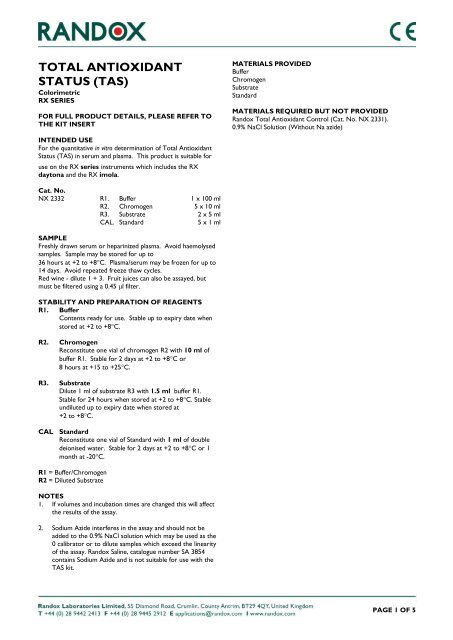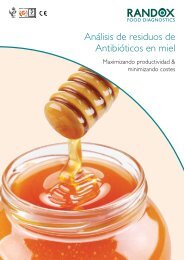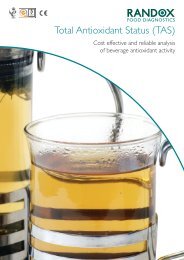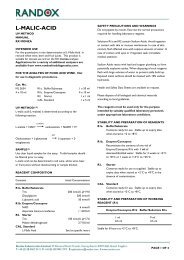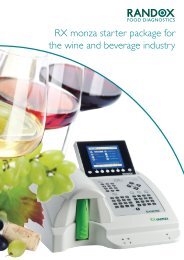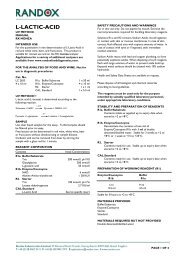total antioxidant status (tas) - Randox Food Diagnostics
total antioxidant status (tas) - Randox Food Diagnostics
total antioxidant status (tas) - Randox Food Diagnostics
You also want an ePaper? Increase the reach of your titles
YUMPU automatically turns print PDFs into web optimized ePapers that Google loves.
TOTAL ANTIOXIDANT<br />
STATUS (TAS)<br />
Colorimetric<br />
RX SERIES<br />
FOR FULL PRODUCT DETAILS, PLEASE REFER TO<br />
THE KIT INSERT<br />
INTENDED USE<br />
For the quantitative in vitro determination of Total Antioxidant<br />
Status (TAS) in serum and plasma. This product is suitable for<br />
use on the RX series�instruments which includes the RX<br />
daytona and the RX imola.<br />
Cat. No.<br />
NX 2332 R1. Buffer 1 x 100 ml<br />
R2. Chromogen 5 x 10 ml<br />
R3. Substrate 2 x 5 ml<br />
CAL. Standard 5 x 1 ml<br />
SAMPLE<br />
Freshly drawn serum or heparinized plasma. Avoid haemolysed<br />
samples. Sample may be stored for up to<br />
36 hours at +2 to +8�C. Plasma/serum may be frozen for up to<br />
14 days. Avoid repeated freeze thaw cycles.<br />
Red wine - dilute 1 + 3. Fruit juices can also be assayed, but<br />
must be filtered using a 0.45 �l filter.<br />
STABILITY AND PREPARATION OF REAGENTS<br />
R1. Buffer<br />
Contents ready for use. Stable up to expiry date when<br />
stored at +2 to +8�C.<br />
R2. Chromogen<br />
Reconstitute one vial of chromogen R2 with 10 ml of<br />
buffer R1. Stable for 2 days at +2 to +8�C or<br />
8 hours at +15 to +25�C.<br />
R3. Substrate<br />
Dilute 1 ml of substrate R3 with 1.5 ml buffer R1.<br />
Stable for 24 hours when stored at +2 to +8�C. Stable<br />
undiluted up to expiry date when stored at<br />
+2 to +8�C.<br />
CAL Standard<br />
Reconstitute one vial of Standard with 1 ml of double<br />
deionised water. Stable for 2 days at +2 to +8�C or 1<br />
month at -20�C.<br />
R1 = Buffer/Chromogen<br />
R2 = Diluted Substrate<br />
NOTES<br />
1. If volumes and incubation times are changed this will affect<br />
the results of the assay.<br />
2. Sodium Azide interferes in the assay and should not be<br />
added to the 0.9% NaCl solution which may be used as the<br />
0 calibrator or to dilute samples which exceed the linearity<br />
of the assay. <strong>Randox</strong> Saline, catalogue number SA 3854<br />
contains Sodium Azide and is not suitable for use with the<br />
TAS kit.<br />
MATERIALS PROVIDED<br />
Buffer<br />
Chromogen<br />
Substrate<br />
Standard<br />
MATERIALS REQUIRED BUT NOT PROVIDED<br />
<strong>Randox</strong> Total Antioxidant Control (Cat. No. NX 2331).<br />
0.9% NaCl Solution (Without Na azide)<br />
PAGE 1 OF 5
RX DAYTONA SETTINGS<br />
RX SERIES NX 2332<br />
PAGE 2 OF 5
RX IMOLA SETTINGS<br />
RX SERIES NX 2332<br />
PAGE 3 OF 5
RX SERIES NX 2332<br />
PAGE 4 OF 5
CALIBRATION<br />
The standard supplied with the kit is recommended for<br />
calibration. A 2 point calibration is recommended every<br />
2 days, with change of reagent lot/bottle or as indicated by<br />
quality control procedures.<br />
This assay uses a linear calculation and no reagent blank.<br />
Ensure that on the Calibration Checks screen the following<br />
are selected for this test:<br />
Reagent Blank Measurement<br />
• Disable Reagent Blank<br />
QUALITY CONTROL<br />
<strong>Randox</strong> Total Antioxidant Control is recommended for daily<br />
quality control. The control should be assayed at least once a<br />
day. Values obtained should fall within a specified range. If these<br />
values fall outside the range and repetition excludes error, the<br />
following steps should be taken:<br />
1. Check instrument settings and light source.<br />
2. Check cleanliness of all equipment in use.<br />
3. Check water, contaminants i.e. bacterial growth may<br />
contribute to inaccurate results.<br />
4. Check reaction temperature.<br />
5. Check expiry date of kit and contents.<br />
6. Contact <strong>Randox</strong> Laboratories RX Support, Northern Ireland<br />
(028) 94451070.<br />
Quality control requirements should be determined in<br />
conformance with government regulations or accreditation<br />
requirements.<br />
SPECIFIC PERFORMANCE CHARACTERISTICS<br />
The following performance characteristics were obtained<br />
using the RX daytona.<br />
LINEARITY<br />
Samples with concentrations greater than 2.94 mmol/l should<br />
be diluted with 0.9% NaCl and reassayed. Dilution of sample<br />
results in up to a 20% increase in values and so is only<br />
recommended if absolutely necessary. The majority of<br />
samples will not require dilution as the results will be less than<br />
2.5 mmol/l.<br />
SENSITIVITY<br />
The minimum detectable concentration of Total Antioxidant<br />
Status with an acceptable level of precision was determined as<br />
0.21 mmol/l.<br />
PRECISION<br />
Intra Assay<br />
Level 1 Level 2 Level 3<br />
Mean (mmol/l) 1.11 1.76 2.43<br />
SD 0.03 0.06 0.07<br />
CV(%) 2.77 3.65 2.83<br />
n 20 20 20<br />
Inter Assay<br />
Level 1 Level 2 Level 3<br />
Mean (mmol/l) 1.11 1.86 2.28<br />
SD 0.07 0.05 0.06<br />
CV(%) 6.06 2.43 2.76<br />
n 20 20 20<br />
RX SERIES NX 2332<br />
PATENT<br />
This product is the subject of UK Patent 2250819 and Patents<br />
and Applications deriving from PCT Patent Application PCT<br />
GB91/02228.<br />
Revised 26 July 11 ck<br />
PAGE 5 OF 5


